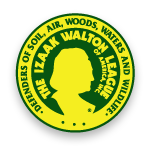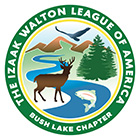Bush Lake ChapterIzaak Walton League of America |
|
Tips for your yard
- Use Water Wisely - to absorb rain and runoff
- Build Good Soil - to help roots grow and rain soak in
- Select Proper Plants - to thrive in your yard's conditions
1. Raise the Mow Height to 3"+ to encourage deeper rooting of turf grass.
2. Keep your mower blade(s) SHARP for clean cuts (to reduce grass blade tearing/excessive moisture loss). Use a mulching blade/don't bag the clippings (leave the fine clippings lay on the lawn). Dremel lawn blade sharpening attachment.
3. Reduce Soil Compaction:
Test for shallow soil compaction with a sturdy wire (e.g. utility locate flag). If you can't push the sturdy wire into the lawn's topsoil more than a 3" depth, you probably have compacted soils (make sure you're not just hitting rocks or tree roots).
Core-plug aeration can help alleviate compaction up to 3" depth. Best time to aerate is in the fall (September).
4. Build Soil Health:
Check out your Soil by taking soil samples.
Send Soil Samples into a Soils Lab for Analysis/Recommendations:
U of M Soil Testing Lab (includes sampling instructions):
Goal for Organic Matter Content % is from 5-8%
For help in interpreting your results, send us an email (and include your results) at bushlake@bushlakeikes.org
If your soil needs more Organic Matter, a good local source is The Mulch Store (have bulk or bagged Well-aged Leaf Compost). The Mulch Store's Burnsville Bulk Materials Yard is west of I-35W & Cliff Road, near the landfill. 1 cubic yard of compost costs around $22 from The Mulch Store.
Well-aged Compost can be top-dressed onto your existing lawn at a 1/8"-1/4" depth in the fall. For new/renovated lawn projects, compost can be incorporated into the soil prior to seeding.
5. Consider Alternative Lawn Plants:
Fine-Fescue Grass Mix (aka "No-Mow Mix" or "Eco-Grass Mix")
Minnesota Bee Lawn Mix (with Fine-Fescues) - (aka MNL Bee Lawn Mix)
Take out a section of lawn and plant native plants. Click for resources from the Board of Water and Soil Resources.
6. Use Water Wisely when Irrigating:
Fix Leaks - small leaks can waste thousands of gallons. Inspect and repair your irrigation system regularly or hire a professional to inspect leaks and conduct an "irrigation audit" to make sure you are watering effectively.
Don't Water the Street: Adjust nozzles to spray only the lawn. For hard to water areas, consider planting something else that doesn't need irrigation.
Don't Water in the Rain: a "rain sensor" signals irrigation controller to turn off when it's actively raining. A "soil moisture sensor" keeps the irrigation controller off if the soil is wet. A "Smart Irrigation Controller" is connected to wi-fi to receive local weather information to determine if it has recently rained or if rain is expected. A "Smart" controller can save approximately 50% of water compared to an old style controller.
Some "Smart" Irrigation Controllers:
Rachio 3 Smart Water System (8-16 zone):
https://www.rachio.com
Rain Bird ST8-WIFI (8 zone):
http://www.rainbird.com/homeowner/products/timers/ST8-WiFi.htm
Orbit b-hyve WiFi Timer (6-12 zones):
https://bhyve.orbitonline.com/
RainMachine Touch HD (12-16 zones):
http://www.rainmachine.com/
7. Harvest Rooftop Rainwater:
Downspout Diverter (Fiskars brand)
Downspout Diverter (EarthMinded brand)
High-Flow Spigot (RainReserve brand)
Rain Barrels (Recycle Minnesota Annual Sale - $74 each)
Rain Barrels (Menards - often have sales in June)
Rain Barrels (Craigslist search)
Water-Smart Landscaping Tips Sheet (2-page pdf)
Questions? Email Gregg at bushlake@bushlakeikes.org
Local Lawn Contractors that specialize in organic lawn care and Fine-Fescue Lawn installation:
Organic Bob: https://organicbob.com/
Organic Lawns by Lunseth: https://www.organiclawnsbylunseth.com/
Top Indoor Water Saving Tips:
1. Upgrade to a High-Efficiency Toilet(s):
- older toilets can use 3-5 gallons per flush;
- new high-efficiency toilets can use 0.8 – 1.28 gallons per flush;
- can reduce water used for toilets by 60-80%
= avg. family of four could save 20,000 – 28,000 gallons per year
2. Upgrade to a High-Efficiency Clothes Washer:
- older clothes washers can use 40 gallons per load;
- new high-efficiency clothes washers use 14-25 gallons per load;
- can reduce water used for clothes washing by 38-65%
= avg. family of four could save 4,500 – 7,800 gallons per year
- can also reduce electricity use
3. Upgrade to a High-Efficiency Shower Head:
- older shower heads can use 2.5 - 5.5 gallons per minute;
- new high-efficiency shower heads can use 1.25 -1.5 gallons per minute;
- can reduce water used for showers by 70-75%
= avg. family of four could save 4,000 – 37,000* gallons per year
(* varies if you currently have a 2.5 or 5.5 gpm shower head)
- can determine by measuring with gallon bucket and stop-watch
- can also reduce electricity or natural gas use (for water heater)
4. Upgrade to a High-Efficiency Dish Washer:
- older dishwashers can use 10-16 gallons per wash cycle;
- new high-efficiency dishwashers use 3 – 5 gallons per wash cycle.
- can reduce water used for washing dishes by 50-80%
= avg. family of four could save 550 – 1,320 gallons per year
- can also reduce electricity use
-
11/18/2025Bush Lake Chapter
-
12/20/2025 8:30 AMBush Lake Chapter


